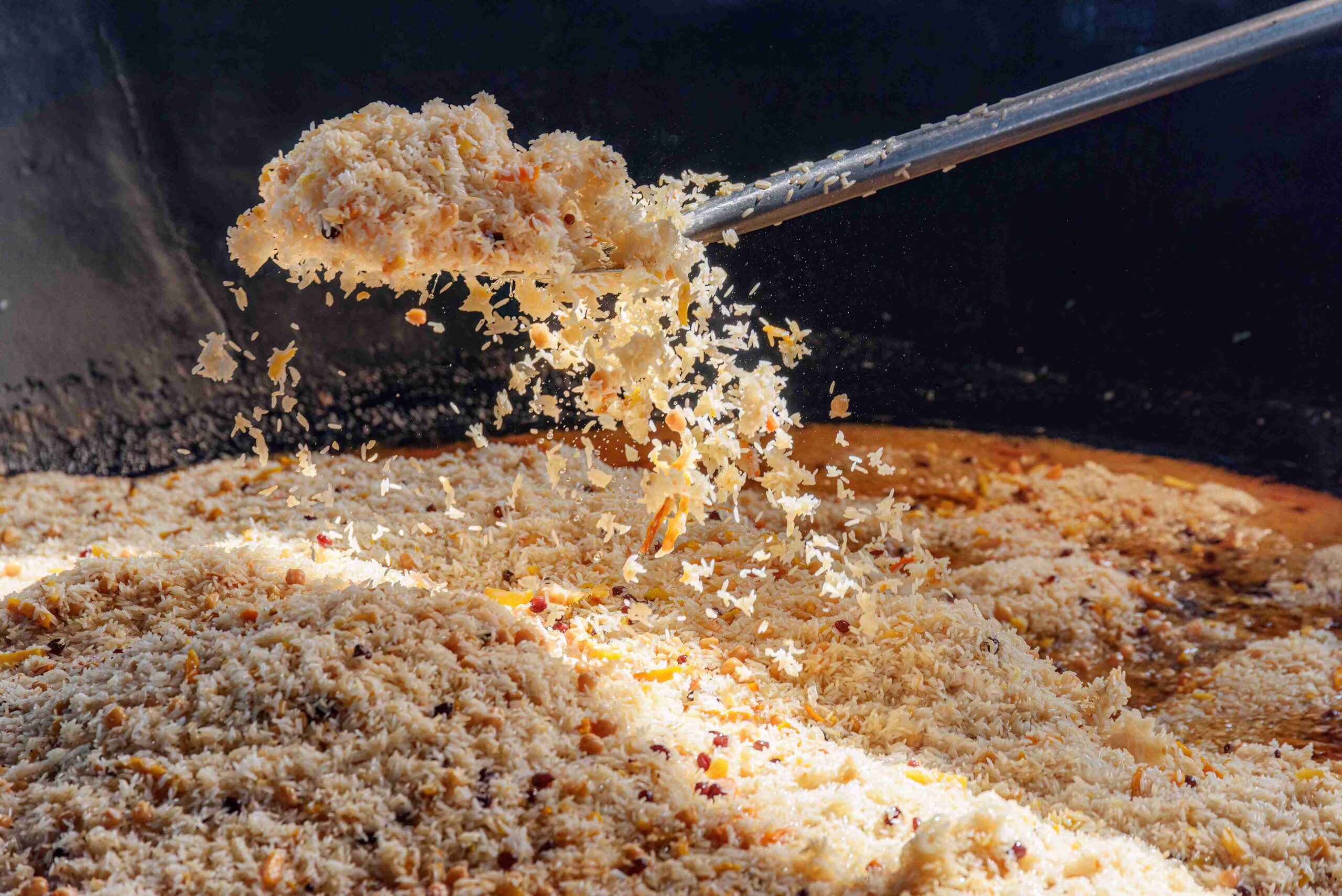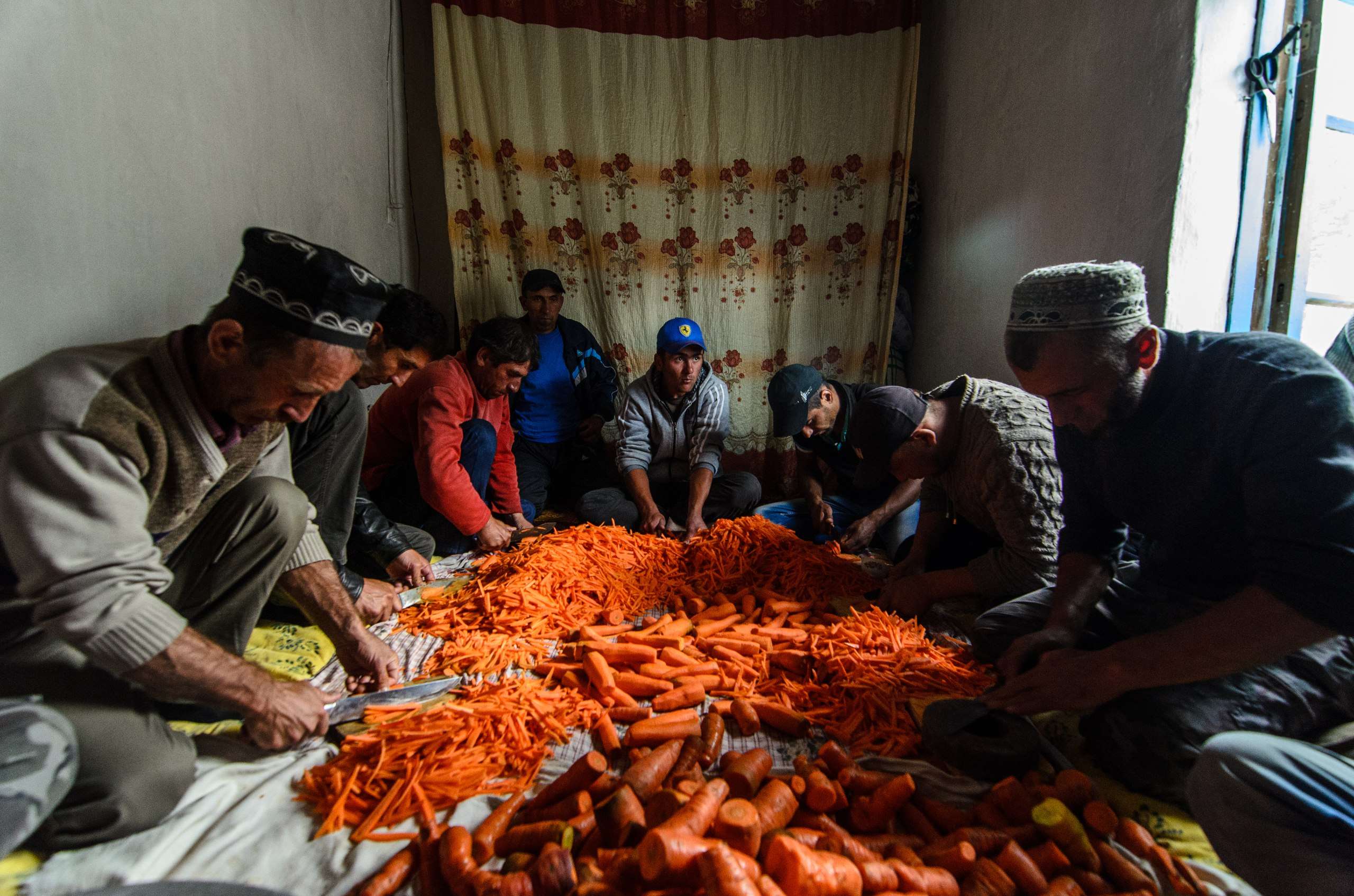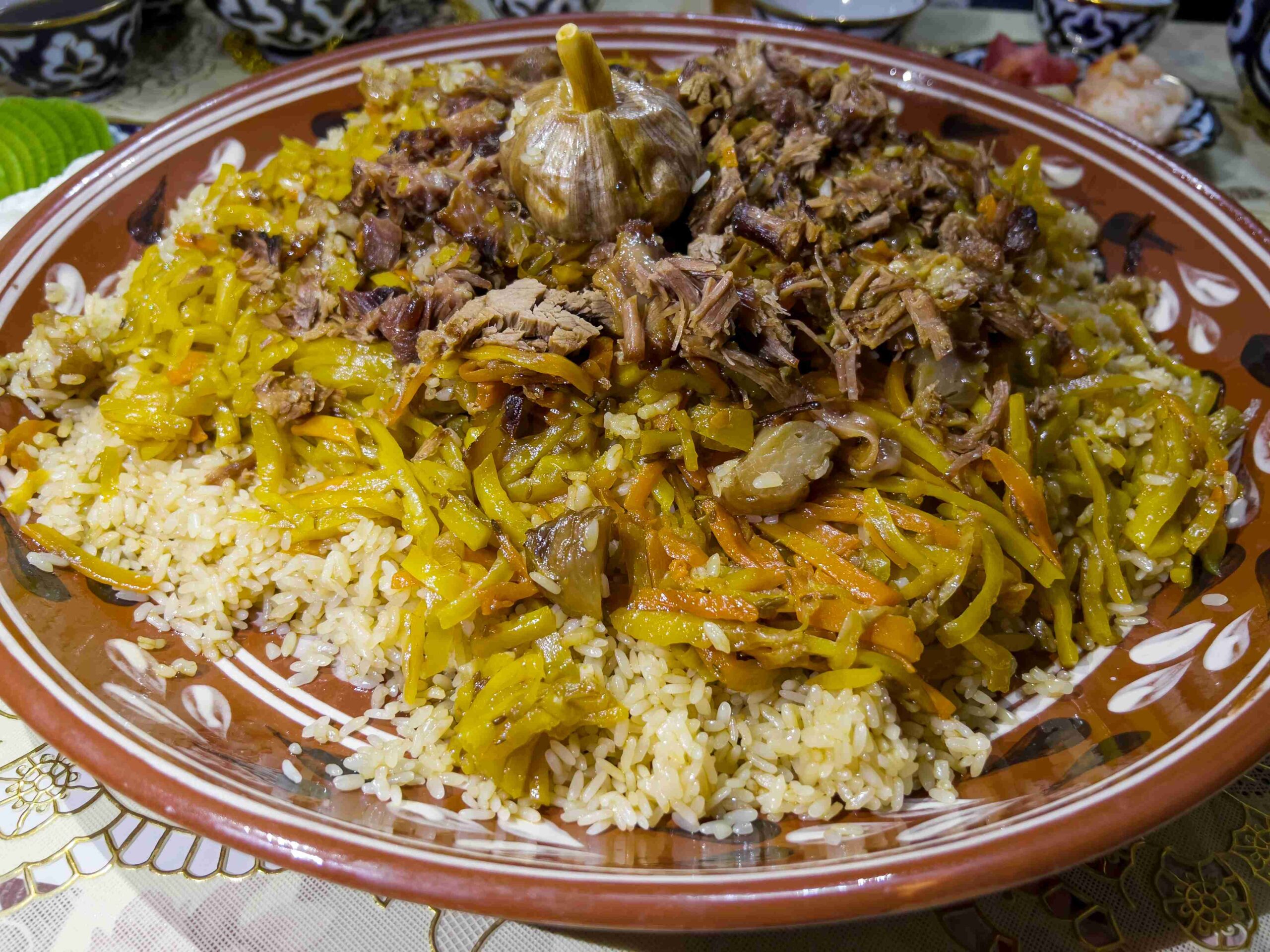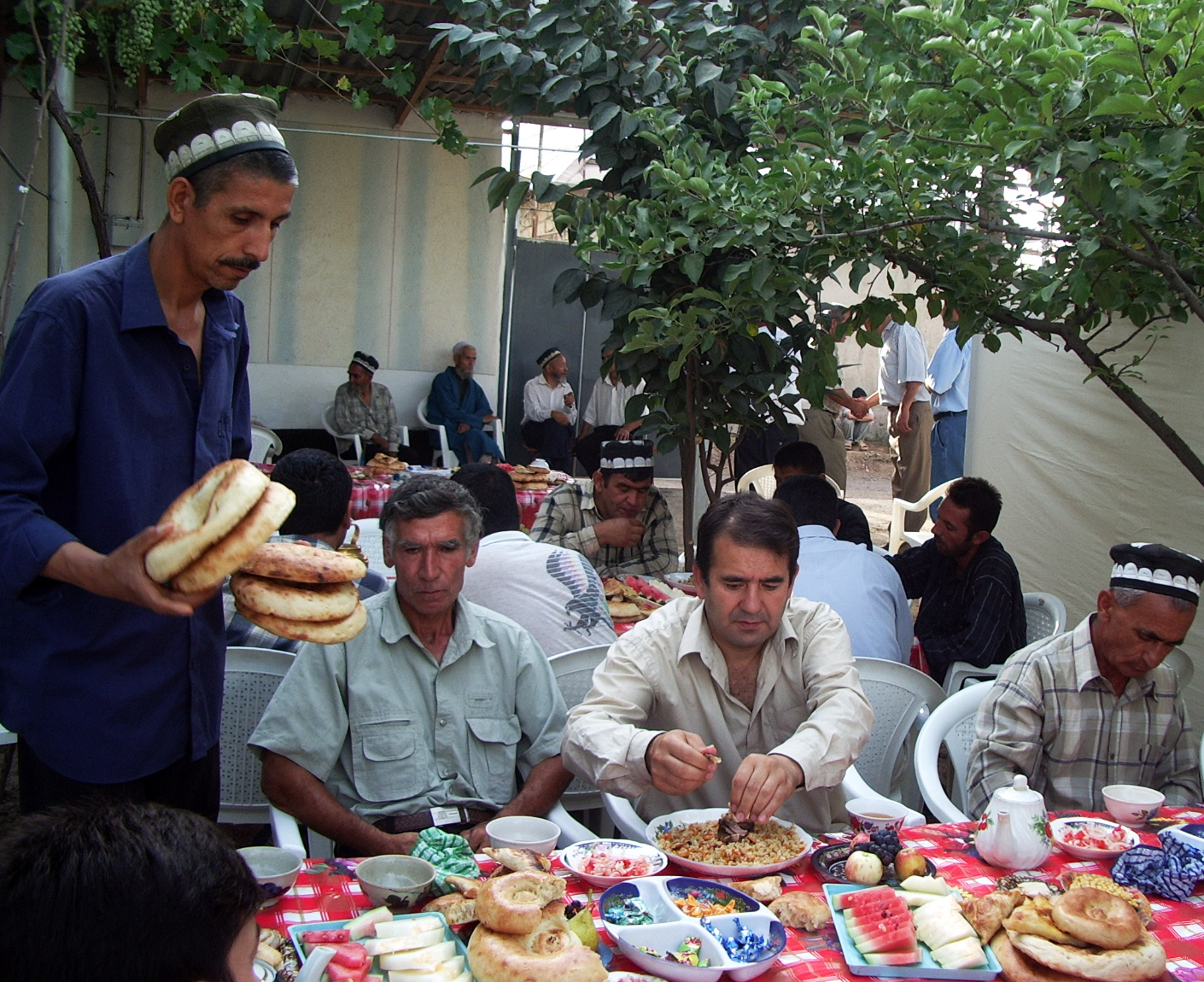Plov – Unity on a Plate: The Crossroads of Culinary Heritage in Central Asia
In many settings, food transcends its role as mere sustenance to become a canvas for national identity, painted with the flavours and aromas of heritage. Central Asia, a region rich in history and culture, offers a culinary mosaic that is as diverse as its landscapes. Among the host of dishes that dot this vibrant region, one stands out for its simplicity, its history, and the debates it sparks: Plov (sometimes known as osh, palav, pilaf, polo, or pilov). However, claiming Plov as belonging to a single nation is overlooking the reality and the depth of Central Asia’s shared heritage. This story is not just about a dish; it is about the people, their nations and their cultures woven through their shared history.
A Dish Without Borders
Amid the rugged terrains and the ancient Silk Roads of Central Asia, a culinary drama has unfolded, with Plov — a dish as hearty as the history of the region itself — at its very centre. The lands of Uzbekistan and Tajikistan, cradles of proud, vibrant cultures and longstanding traditions, find themselves locked in a passionate debate over the origins of this beloved dish, with each nation proclaiming Plov as a cornerstone of their gastronomic heritage. This culinary contest is more than a matter of recipes; it is a declaration of cultural identity.
This debate transcended national borders and found its way to the grand stage of UNESCO, where the organization inscribed both the Uzbek and Tajik interpretations of Plov in the Representative List of the Intangible Cultural Heritage of Humanity. By this act, UNESCO has shown the centrality of Plov to community, tradition, hospitality and identity in both nations. While the actual claim for the dish as the very substance of one nation over the other remains unresolved, there is no doubt that the passion for Plov both as a food and as a symbol of culture is as strong as ever.
Tracing the genesis of Plov reveals a culinary journey as complex and intertwined as the history of Central Asia itself. The earliest documented recipe for pilaf comes from the 10th-century Tajik scholar Avicenna (Ibn Sina) from Bukhara. Known for his groundbreaking work in medicine, Avicenna also made significant contributions to the culinary arts. Meanwhile, in his extensive writings on medical science, he dedicated an entire section to cooking, detailing the preparation of various pilaf (plov) recipes. Remarkably, he analyzed the nutritional benefits and potential drawbacks of each ingredient, blending gastronomy with scientific inquiry.

The Origins and Story of Plov
The origins of the dish trace back even further. In the 4th century BCE, Alexander the Great and his army encountered flavorful rice dishes in Bactria and Sogdiana (modern-day Central Asia). So impressed were his soldiers by these early versions of pilaf that they reportedly brought the recipes back to Macedonia, spreading the dish throughout the ancient world.
The journey of this beloved dish remains shrouded in mystery, enriched by two predominant theories proposing different cradles of Plov, consequently reflecting a melting pot of culinary traditions:
Many suggest Plov’s ancestral roots lie deep in ancient Persia, where it emerged as a staple before weaving its way along the Silk Road. This path brought Plov into the culinary landscapes of India and Pakistan, intertwining with local traditions and ingredients.
An alternate theory proposes an intriguing reversal, placing Plov’s birth in the Indian subcontinent. According to this perspective, Indian pilaf served as the precursor to Plov, which then traveled westward to Persia. This potential origin highlights the dynamic nature of trade and cultural exchange, illustrating how geography and agriculture shaped Plov’s evolution.
Both theories underscore the rich tapestry of influences shaping Central Asian cuisine. Whether emerging from Persia’s fertile valleys or India’s vibrant markets, Plov’s journey reflects a melting pot of culinary traditions. As it traversed the Silk Road, it absorbed a mosaic of flavors and techniques, resulting in the diverse regional variations celebrated across Central Asia today.

Well-known Central Asian types of Plov and their distinctive features
Samarkand Plov
Originating from one of the oldest continuously inhabited cities in Central Asia, Samarkand Plov is known for its simplicity and elegance. It often features yellow carrots (a preference in some parts of Uzbekistan), rice, and meat (usually lamb), with a hint of cumin and whole heads of garlic added for extra flavor. This Plov is cooked in layers, which helps to retain the distinct taste of each ingredient.
Panjakent Plov
Hailing from the ancient city of Panjakent in Tajikistan, this version of Plov is very similar to Samarkand Plov. You can distinguish this plov by its use of local spices and herbs, reflecting the city’s role as a trading hub on the ancient Silk Road. Panjakent Plov is often served during significant events such as weddings, family gatherings, and festivals. It is a dish that symbolizes hospitality and abundance, reflecting the generosity of Tajik culture.
Khujand Plov
This type of Plov comes from Khujand, one of the oldest cities in Tajikistan. It is known for a special variety of rice – kenja – grown in Khujand and for its rich use of spices and the inclusion of chickpeas alongside the traditional ingredients of rice, meat, and carrots. The Khujand Plov is often cooked with a generous amount of meat and fat and sometimes with quail eggs on the top, giving it a distinctive, rich flavor.
Fergana Plov
From the Fergana Valley, which spreads across eastern Uzbekistan, western Kyrgyzstan, and northern Tajikistan, you can recognize this Plov by its aromatic and oily nature. It often features quince or other local fruits added to the mix, creating a unique sweet and savory flavour profile.
Uzgen Plov
Originating from the Uzgen district in Kyrgyzstan, known for its ancient minarets and mausoleums, Uzgen Plov is made with a special variety of red rice grown in the region. This gives the dish a distinctive color and texture. It typically includes carrots, onions, and either lamb or beef, with a simple but flavourful seasoning.
Bukhara Plov
Known as Oshi Sofi, this dish holds deep cultural and spiritual significance, often prepared for religious gatherings and feasts. Unlike other Plov varieties, it features a sweet-savory balance with dried fruits like raisins, apricots, and barberries (zereshk), alongside slow-cooked lamb or mutton. Made with devzira rice, known for its firm texture, it is mixed rather than layered, blending caramelized onions, cumin, and coriander into a rich, aromatic dish. Traditionally cooked in a copper kazan (copper pot) over an open flame, Oshi Sofi reflects Bukhara’s Silk Road heritage, hospitality, and communal traditions.

In most Central Asian countries, as well as in Tajikistan, although families often prepare this cherished dish at home, it transforms into a culinary spectacle when entrusted to an oshpaz – a master of the art of Plov. These skilled chefs, revered for their expertise, use enormous cauldrons called deg (kazan, qozon or qazan), cooking over open flames to feed hundreds, sometimes even a thousand people. Such an event is more than a meal; it is a performance, a tradition steeped in history and culture.
Oshi Nahor: A Morning Plov Celebration
One of the most remarkable Plov rituals is the preparation of oshi nahor, or “morning plov”. The scene unfolds in the early hours, long before the sun has fully risen. Between 6 and 9 a.m., guests begin to arrive, drawn by the promise of a feast and the warmth of community. The occasion is often tied to a wedding celebration, where this early-morning gathering is as much about strengthening bonds as it is about the food itself. Served generously, the plov becomes a symbol of abundance and unity. Guests, seated shoulder to shoulder, share stories, laughter, and the delicious dish. In that moment, oshi nahor is more than just a meal – it is a celebration of life, love, and tradition, passed down through generations.

Thus, Plov stands as a culinary emblem of Central Asia, intricately woven into the fabric of the region’s cultural identity and communally shared history. Recognized internationally by UNESCO as a national dish of both Uzbekistan and Tajikistan, its fascinating and delicious regional variations highlight the diverse cultural landscapes from which it hails. Each version of Plov, from the sunlit valleys of Uzbekistan to Tajikistan’s rugged terrains, tells a unique story of tradition, community, culinary artistry and landscape as expressed by localized ingredients. Despite fascinating local adaptations which express the rich heritage and nuanced flavours of Central Asian cuisine, the basis of the dish shows the shared legacy that transcends borders. As Plov continues to bring people together, it embodies a richness inherent in the history and culture of the region, reminding us that this cherished dish symbolizes not just ownership, but a heritage collectively savoured across generations and regions.
Written by Farhodbek Fayzullaev
specially for Paramount Journey.



